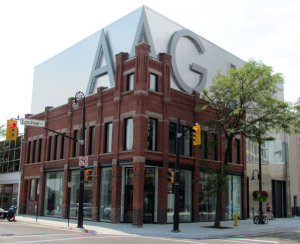by Cathy Dobson the Sarnia Observer
(2012) The ladies would be pleased.
When the $10.3-million Judith & Norman Alix Art Gallery opens in two months, a century-old dream shared by an enterprising group of Sarnia women will finally be fulfilled.
In the early 1900s, women like Maizie Gurd, Kate Murphy and Norah Rooney came together to form the 10-member Sarnia Women’s Conservation Committee. Their initial mandate was to support the troops with medical supplies and socks during the First World War, but they eventually became an integral part of the Sarnia art movement in the 1920s. It was their foresight and commitment to Sarnia’s burgeoning cultural movement in the first half of the 20th century that formed the basis of today’s multi-million permanent art collection.
There are currently 1,125 art pieces that belong to Sarnia-Lambton, some as prominent as Edwin Holgate’s The Lumberjack and some much more obscure.
The ladies’ committee started out humbly enough. During the war, they collected rags and newspapers and sold them to recyclers. When the war ended they teamed up with Norman Gurd, a local lawyer and member of the Sarnia library board, who suggested their money could be spent buying paintings and sculptures.
It was Gurd’s opinion that a city-owned art collection could be an educational tool to show the public “what good art really is.”
“Gurd wanted Sarnia to present itself as a community that was about more than just oil,” said gallery curator Lisa Daniels. “He wanted to start a Sarnia art movement, so he worked with the women to bring in shows, hold a lecture series and sell some of the paintings.”
Gurd had connections to emerging Canadian artists, including Tom Thomson and some of the painters destined to become The Group of Seven.
The committee purchased their first three paintings in 1920 from some of these Toronto-based artists, including H.S. Palmer’s “Sawing Logs,” J.W. Beatty’s “Winter Scene (Near Toronto)” and A.Y. Jackson’s “Fall in Lower Canada.” Together, the three paintings cost $700. Just as the building of the new art gallery is now prompting some residents to criticize, the ladies’ investment in art drew a fair amount of criticism too.
But the women were insistent. They held their first art showing in March 1920 at the original Carnegie library, which stood at the corner of Wellington and Christina streets. And they talked about their commitment to a public gallery that would draw more art to the city and nurture local arts.
“What they did wasn’t just about buying a few paintings,” Daniels said. “It changed the feeling in the community because it contributed so much to the music, photography and arts scene that was emerging in Sarnia at the time.”
In 1924 the women renamed their group the Sarnia Women’s Conservation Art Association. In the early ‘20s they raised substantial money, organized numerous travelling exhibitions and bought some of the most prominent paintings in the collection, including the Holgate and 12 Arctic sketches by Jackson.
The Depression had a devastating impact on their purchasing power. The prices paid for rags and newspapers fell and the ladies bought far less through the ‘30s and ‘40s. Their hopes of establishing a permanent gallery for their growing public collection grew dim. The women were getting older and several died before the upper storey of the new library was designated for use as an art gallery in 1961.
The collection found a home in the library building, but eventually the Art Gallery of Ontario refused to loan works to Sarnia because the hanging system was substandard.
In 1994, the collection was moved to a new 7,800-square-foot gallery in The Bayside Mall. But climate control in the mall was a problem. Many in the community criticized the mall space for being too sterile. Over the years, a number of fundraising attempts were made to establish a new standalone gallery to house the permanent collection.
None was successful until Lambton County’s politicians threw their support behind a major new gallery building.
When the 18,400-square-foot Judith & Norman Alix Art Gallery opens at the corner of Christina and Lochiel streets on Oct. 5, it will play a key role in the community’s cultural growth. With space enough for the permanent collection, well-rounded educational programs and climate controlled galleries, it will also be the kind of facility envisioned so many years ago by the ladies of the Sarnia Conservation Committee.
“What we’re seeing now with the new gallery is the same creative intention that existed for those 10 women,” said Daniels.
The gallery is key to the city’s cultural rebirth but so is an assortment of other activities that includes First Fridays, Artwalk, the Imperial Oil Centre for the Performing Arts, the Lawrence House Centre for the Arts, Stones ‘N Bones Museum and any number of boutiques and trendy restaurants in the downtown core, she said.
“Their work to change the feeling in the community became an art movement in the 20s. I think it’s happening again.”
In the weeks leading up to the opening of the Judith & Norman Alix Art Gallery, The Observer will feature a weekly series highlighting some of the most noteworthy works in the permanent collection. Watch for “The Art of the City” starting Friday.


